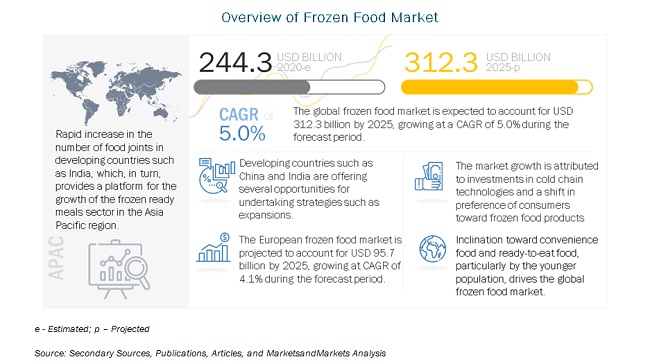The frozen food market is estimated to account for about USD 244.3 billion in 2020 and is projected to reach a value of about USD 312.3 billion by 2025, at a CAGR of 5.0%. Developments in the retail landscape, rising demand for convenience food, and technological advancements in the cold chain market are the major driving factors for the market. On the other hand, the rising preference for fresh and natural food products is a restraining factor for the market.

Opportunities: Digitalization of the retail industry
One of the latest trends driving the market is online grocery shopping and the introduction of new apps, making it convenient for consumers to pick their preferred products. Consumers are inclined toward online shopping due to features of convenience and variety. According to Eurostat, in 2018, almost 25% of the population bought food and groceries from online retail channels. With the growing penetration of the Internet and smartphone usage, retail grocery shopping is emerging as one of the platforms for companies to showcase and sell their food products.
Download PDF Brochure: https://www.marketsandmarkets.com/pdfdownloadNew.asp?id=130
Challenges: Lack of cold chain infrastructure in developing economies
Cold chain logistics have proved to be a vital requirement to increase the market share of frozen food in any country. However, developing countries are still lacking in cold chain infrastructure and are unable to supply safe frozen food products to their citizens. Frozen food has a long shelf-life; however, due to lack of infrastructure, the product is wasted easily leading to a loss for frozen food manufacturers. Lack of investment due to the monetary crisis in developing economies has been one reason slowing down the cold chain logistics business. This, in turn, has hampered the frozen food market. Poor infrastructure in cold chain logistics has also directly impacted the import & export business of frozen food products in developing countries such as Bangladesh, South Africa, and Myanmar. However, these developing countries offer a huge opportunity for investment in the market due to the rising acceptance among consumers in urban areas.
The convenient & ready meals segment is estimated to dominate the global market in 2020.
By product, the convenient & ready meals segment is estimated to dominate the global market in 2020. This is due to the changing and busy lifestyles of people, globally, which has increased the consumption of frozen foods, globally. Frozen foods are easy to prepare and take less time for preparation. They are healthy and have high nutritional value. Frozen food export business has also increased in recent times due to the high acceptance of these products among consumers and brand awareness among developing countries.
Europe is estimated to dominate the frozen food market in 2020.
Europe is estimated to account for the largest market share in the frozen food market in 2020. The region is projected to offer huge growth potential to the frozen food market. The market in Germany is estimated to be the major contributor to the growth in the region. The European market is driven by the robust growth of the food industry, which has supported the ready-to-eat snack food industry to gain acceleration in this market.
Request for Customization: https://www.marketsandmarkets.com/requestCustomizationNew.asp?id=130
This report includes a study of marketing and development strategies, along with the product portfolios of the leading companies in the frozen food market. It includes the profiles of the leading companies such as General Mills Inc (US), Conagra Brands, Inc. (US), Grupo Bimbo S.A.B. de C.V. (Mexico), Nestle SA (Switzerland), Unilever (Netherlands), Kellogg Company (US), McCain Foods Limited (Canada), Kraft Heinz Company (US), Associated British Foods plc (UK), Ajinomoto (Japan), Vandemoortele NV (Belgium), Lantmannen Unibake International (Denmark).
Recent Developments:
- In June 2018, Lantmännen Unibake opened up a new production plant in Nowa Sól, Poland to increase its production capabilities.
- In October 2018, Conagra acquired Pinnacle Foods Inc. (US); the acquisition helped Pinnacle foods to widen its frozen meals & snacks and sweet treats categories.
- In September 2018, Grupo Bimbo added four frozen bakery lines to its Argentina plant. This step was taken to increase the export business of the company in neighboring countries such as Chile.
- In November 2018, Nestle launched Wildspace, a range of healthy frozen meals in reusable and recyclable containers. Wildscape meals include six different varieties, such as the gochujang cauliflower with Brussel sprouts, quinoa, chickpeas, pickled onions, riced cauliflower, and cashews.